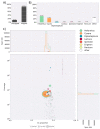Population Genomic Approaches for Weed Science
- PMID: 31546893
- PMCID: PMC6783936
- DOI: 10.3390/plants8090354
Population Genomic Approaches for Weed Science
Abstract
Genomic approaches are opening avenues for understanding all aspects of biological life, especially as they begin to be applied to multiple individuals and populations. However, these approaches typically depend on the availability of a sequenced genome for the species of interest. While the number of genomes being sequenced is exploding, one group that has lagged behind are weeds. Although the power of genomic approaches for weed science has been recognized, what is needed to implement these approaches is unfamiliar to many weed scientists. In this review we attempt to address this problem by providing a primer on genome sequencing and provide examples of how genomics can help answer key questions in weed science such as: (1) Where do agricultural weeds come from; (2) what genes underlie herbicide resistance; and, more speculatively, (3) can we alter weed populations to make them easier to control? This review is intended as an introduction to orient weed scientists who are thinking about initiating genome sequencing projects to better understand weed populations, to highlight recent publications that illustrate the potential for these methods, and to provide direction to key tools and literature that will facilitate the development and execution of weed genomic projects.
Keywords: genome scans; genomics; non-target site resistance; plant genome assembly; population genetics; population genomics; weeds.
Conflict of interest statement
The authors declare no conflict of interest.
Figures


Similar articles
-
The power and potential of genomics in weed biology and management.Pest Manag Sci. 2018 Oct;74(10):2216-2225. doi: 10.1002/ps.5048. Epub 2018 Jun 12. Pest Manag Sci. 2018. PMID: 29687580 Review.
-
Weed genomics: new tools to understand weed biology.Trends Plant Sci. 2004 Aug;9(8):391-8. doi: 10.1016/j.tplants.2004.06.003. Trends Plant Sci. 2004. PMID: 15358270 Review.
-
The role of population and quantitative genetics and modern sequencing technologies to understand evolved herbicide resistance and weed fitness.Pest Manag Sci. 2021 Jan;77(1):12-21. doi: 10.1002/ps.5988. Epub 2020 Jul 24. Pest Manag Sci. 2021. PMID: 32633005 Free PMC article.
-
Current status of community resources and priorities for weed genomics research.Genome Biol. 2024 May 27;25(1):139. doi: 10.1186/s13059-024-03274-y. Genome Biol. 2024. PMID: 38802856 Free PMC article. Review.
-
Weed genomics: yielding insights into the genetics of weedy traits for crop improvement.aBIOTECH. 2023 Jan 9;4(1):20-30. doi: 10.1007/s42994-022-00090-5. eCollection 2023 Mar. aBIOTECH. 2023. PMID: 37220539 Free PMC article. Review.
Cited by
-
Exploring the genetic progression of MDR1 in Plasmodium falciparum: A decade of multi-regional genetic analysis (2014-2024).Curr Res Microb Sci. 2024 Oct 26;7:100304. doi: 10.1016/j.crmicr.2024.100304. eCollection 2024. Curr Res Microb Sci. 2024. PMID: 39534723 Free PMC article.
-
Biotechnological Road Map for Innovative Weed Management.Front Plant Sci. 2022 Apr 25;13:887723. doi: 10.3389/fpls.2022.887723. eCollection 2022. Front Plant Sci. 2022. PMID: 35548307 Free PMC article. Review.
-
Common evolutionary trajectory of short life-cycle in Brassicaceae ruderal weeds.Nat Commun. 2023 Jan 18;14(1):290. doi: 10.1038/s41467-023-35966-7. Nat Commun. 2023. PMID: 36653415 Free PMC article.
-
Herbicide Resistance in Plants.Plants (Basel). 2020 Apr 1;9(4):435. doi: 10.3390/plants9040435. Plants (Basel). 2020. PMID: 32244672 Free PMC article.
-
Standing genetic variation fuels rapid evolution of herbicide resistance in blackgrass.Proc Natl Acad Sci U S A. 2023 Apr 18;120(16):e2206808120. doi: 10.1073/pnas.2206808120. Epub 2023 Apr 12. Proc Natl Acad Sci U S A. 2023. PMID: 37043536 Free PMC article.
References
Publication types
Grants and funding
LinkOut - more resources
Full Text Sources

